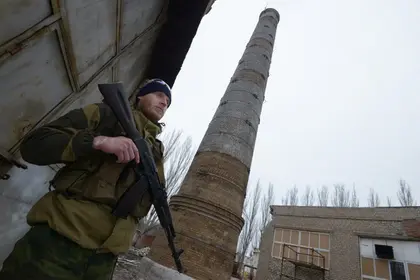Yenakiyeve, the hometown of ex-President Viktor Yanukovych, had a pre-war population of more than 80,000 people, but more than half are gone — making the gritty city resemble a ghost town.
The big city sign is painted in the colors of the Russian-separatist fighters who control it.
A metal and steel factory in the city center used to be the top employer.
The factory is part of billionaire Rinat Akhmetov MetInvest Group. It doesn’t work much though. If it did, the thick black smoke would soar about the city and could be seen for miles. It used to be a symbol of the Donbas, known for its large coal industry.
“Around the city there are more, true symbolic Donbas factories. We have coal, metal, and much more,” said an old man who introduced himself only as Vladimir. He smokes a cigarette at a bus stop on a small bridge as he overlooks the factory behind brick walls. “My son used to work there, but now he left to Kramatorsk. It’s better there. But because it’s better there, it doesn’t mean he supports the Ukrainian government!”
Although Yenakiyeve’s metal and steel factory stands idle, the coal mines are partly operating and doing business. Large trucks are transporting coal, and the usual train tracks aren’t used, making it a rather expensive business in Kremlin-occupied territories. Gasoline is more expensive, but according to Vitaliy, a 31-year-old government worker at Yenakiyeve’s regional city administration, there is no other option. “There are not enough train wagons to transport coal. The Ukrainians have them, and they won’t send any into our territory,” he explained, refusing to give his full name because he is not authorized to talk to the press.
It’s hard to find someone who can identify the buyer of the coal.
A spokesperson of Yenakiyeve’s regional city administration didn’t give details. “As you can guess, they’re not doing business with Ukraine,” the spokesperson told the Kyiv Post before abruptly hanging up the phone.
Acres of unharvested sunflower fields dot the country landscape.
“This used to be a battle zone,” says Ilya, a 29-year-old driver, pointing at the foxholes and trenches.
It is no more after Russian-separatist forces defeated Ukrainian troops.
“The Novorossiya Armed Forces surrounded the Ukrainians, and at last killed them,” Ilya said, worrying that giving his last name could get him “detained or worse” by the separatists he nonetheless supports.
The road to Yenakiyeve is a no-man’s-land.
Tank tracks are still visible.
Farmers have fled.
Eeven though the biggest clashes have been over for a year, little has been done to restore the region to normalcy.
Still, residents in the destitute region fear that “Ukrainian Nazis will push forward soon.”
According to 51-year-old Olena Fedina, a Yenakiyeve resident, the war will likely return to the small city.
She recalls the enormously heavy shelling of the town of Vuhlehirsk, just some 10 kilometers north of Yenakiyeve.
“When Vuhlehirsk was ravaged, I got flashbacks from last summer. War is everywhere. The real question is: what is next? Apparently, both the Ukrainians and (separatists) want to take more land. That means more fighting, more blood and more sorrow!” she yelled.
Fedina doesn’t want to flee to Ukrainian-held territory. “I will be looked down at. They see me as the enemy, but I’m not. Men with Kalashnikovs are the enemy, not people like me, who are only victims of an idiotic war.”
You can also highlight the text and press Ctrl + Enter




